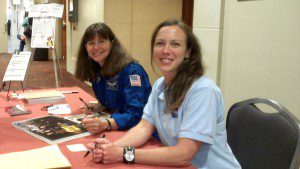It might have been the best kept secret of WorldCon. There was an entire track about NASA, the astronaut missions, working in aerospace, asteroid detection, and more. I didn’t get a chance to see as much as I would have liked, of course.
Shuttle and Science
Astronaut Cady Coleman gave a talk on her missions and showed video of everyday life on the International Space Station. She also spoke on another panel about women in aerospace, in which several women who worked for NASA discussed the barriers and also the lack of barriers to a career in STEM.
What I came away with was that sometimes we look for barriers where there are none. Now that nothing keeps women from entering college and studying the subjects of their own choosing, there might be individuals who are obnoxious, but when everyone is focusing on the same mission, the jerks who are playing the gender game fall by the wayside.
Sexism: Don’t let it stop you
Coleman was circumspect in talking about one Russian astronaut who gave her a hard time on one shuttle mission. Yes, he had a problem with women in the space program. She often had to communicate with him through a male colleague. But as she pointed out, when you are where you want to be, doing important work, you don’t let that stop you. She also told us that he was so unpleasant with his male colleagues too, that the joke was he flew with foreign astronauts because the other Russians didn’t want him. So hah! Russian dude who is still in the 19th century. Take that.
One of Coleman’s jobs on the shuttle was capturing supply ships with the robotic arm. She and another astronaut were the only two people who had the job; both women, in fact. She said that for a while there it was starting to look like only women could do it, until obviously people came to their senses and let a male astronaut try. For goodness sake’s, it’s not like they’re incapable or something. (See what I did there?)
There and Back Again
She was all for the space mission’s partnership with commercial companies (note; not the same as the civilian contractors that have always been highly involved in building the shuttle and rockets). Commercial companies can move faster and make decisions faster. However, before developing missions to Mars, there’s still plenty of testing and science that has to be done. There are environmental issues at least once a week on the shuttle. New ships will have to be much more robust.
The science done on the shuttle included crystal growth for drug development, osteoporosis experiments (she suffered a great deal of bone loss, but the effects were not permanent in large part due to the amount of load-bearing exercise she did while in space.) Preventing bone loss is going to be a significant part of a successful mission to Mars, she said; otherwise you will have “spaghetti people” going to Mars and not being able to open the door when they get there.
Stopping Asteroids
Paul Abell talked about asteroid detection. He called it NASA’s “grand challenge.” How do you protect the planet against asteroids, especially the kind that can, as he put it, “give us a really bad day”? You have to find them far enough out that you can make minor adjustments to their trajectory to push them out of the way. And then you have to re-calculate to make sure they stay out of the way. The panel talked about gravitational tractors, the nuclear option, even the gentler method of painting the rock white, changing the temperature, and altering its direction that way.
Thanks so much to all of the scientists who contributed to WorldCon.
There was a lot of talk about the Chelyabinsk asteroid, and why no one detected it until it detonated over the city. The rock came from the direction of the sun, and therefore it was impossible to see. Clearly this is a blind spot that needs to be fixed before we can prevent a worse disaster.


0 Comments